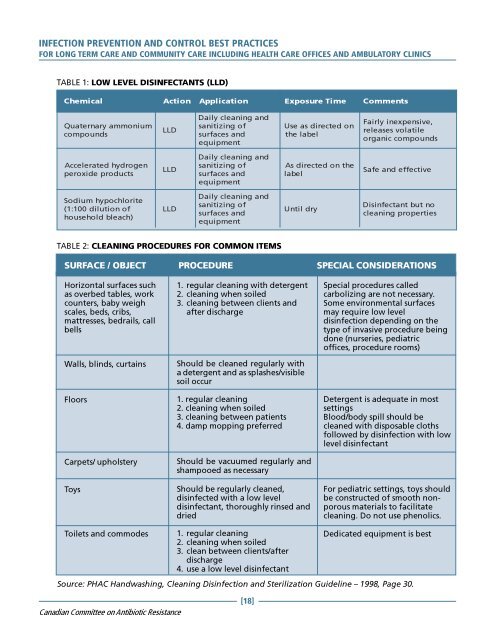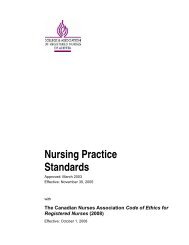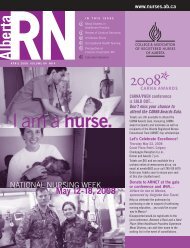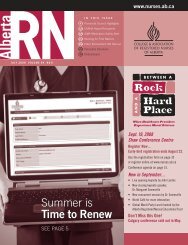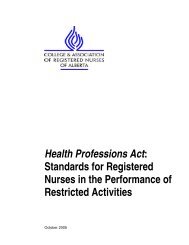Infection Prevention and Control Best Practices - College ...
Infection Prevention and Control Best Practices - College ...
Infection Prevention and Control Best Practices - College ...
You also want an ePaper? Increase the reach of your titles
YUMPU automatically turns print PDFs into web optimized ePapers that Google loves.
INFECTION PREVENTION AND CONTROL BEST PRACTICES<br />
FOR LONG TERM CARE AND COMMUNITY CARE INCLUDING HEALTH CARE OFFICES AND AMBULATORY CLINICS<br />
TABLE 1: LOW LEVEL DISINFECTANTS (LLD)<br />
ChemicalAction Application ExposureTime Comments<br />
Quaternary<br />
ammonium<br />
compounds<br />
Accelerated<br />
hydrogen<br />
peroxide<br />
products<br />
Sodium<br />
hypochlorite<br />
( 1:<br />
100<br />
dilution<br />
of<br />
household<br />
bleach)<br />
LLD<br />
LLD<br />
LLD<br />
Canadian Committee on Antibiotic Resistance<br />
Daily<br />
cleaning<br />
sanitizing<br />
of<br />
surfaces<br />
<strong>and</strong><br />
equipment<br />
Daily<br />
cleaning<br />
sanitizing<br />
of<br />
surfaces<br />
<strong>and</strong><br />
equipment<br />
Daily<br />
cleaning<br />
sanitizing<br />
of<br />
surfaces<br />
<strong>and</strong><br />
equipment<br />
[18]<br />
<strong>and</strong><br />
<strong>and</strong><br />
<strong>and</strong><br />
TABLE 2: CLEANING PROCEDURES FOR COMMON ITEMS<br />
Use<br />
the<br />
as<br />
directed<br />
on<br />
label<br />
As<br />
directed<br />
on<br />
the<br />
label<br />
Until<br />
dry<br />
Fairly<br />
inexpensive,<br />
releases<br />
volatile<br />
organic<br />
compounds<br />
Safe<br />
<strong>and</strong><br />
effective<br />
Disinfectant<br />
but<br />
no<br />
cleaning<br />
properties<br />
SURFACE / OBJECT PROCEDURE SPECIAL CONSIDERATIONS<br />
Horizontal surfaces such<br />
as overbed tables, work<br />
counters, baby weigh<br />
scales, beds, cribs,<br />
mattresses, bedrails, call<br />
bells<br />
Walls, blinds, curtains<br />
Floors<br />
Carpets/ upholstery<br />
Toys<br />
Toilets <strong>and</strong> commodes<br />
1. regular cleaning with detergent<br />
2. cleaning when soiled<br />
3. cleaning between clients <strong>and</strong><br />
after discharge<br />
Should be cleaned regularly with<br />
a detergent <strong>and</strong> as splashes/visible<br />
soil occur<br />
1. regular cleaning<br />
2. cleaning when soiled<br />
3. cleaning between patients<br />
4. damp mopping preferred<br />
Should be vacuumed regularly <strong>and</strong><br />
shampooed as necessary<br />
Should be regularly cleaned,<br />
disinfected with a low level<br />
disinfectant, thoroughly rinsed <strong>and</strong><br />
dried<br />
1. regular cleaning<br />
2. cleaning when soiled<br />
3. clean between clients/after<br />
discharge<br />
4. use a low level disinfectant<br />
Special procedures called<br />
carbolizing are not necessary.<br />
Some environmental surfaces<br />
may require low level<br />
disinfection depending on the<br />
type of invasive procedure being<br />
done (nurseries, pediatric<br />
offices, procedure rooms)<br />
Detergent is adequate in most<br />
settings<br />
Blood/body spill should be<br />
cleaned with disposable cloths<br />
followed by disinfection with low<br />
level disinfectant<br />
For pediatric settings, toys should<br />
be constructed of smooth nonporous<br />
materials to facilitate<br />
cleaning. Do not use phenolics.<br />
Dedicated equipment is best<br />
Source: PHAC H<strong>and</strong>washing, Cleaning Disinfection <strong>and</strong> Sterilization Guideline – 1998, Page 30.


